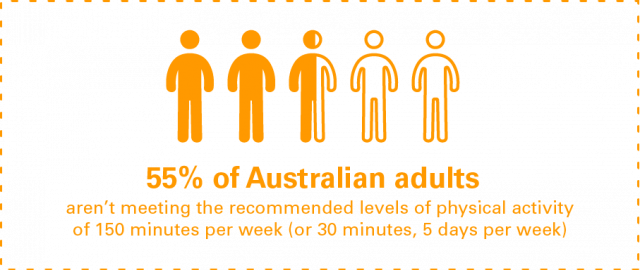WELLBEING AND CONNECTION
Build engagement through a corporate challenge
As the boundaries between life and work have continued to blur in a post-pandemic world, the struggle to help employees feel connected within a hybrid working environment has been at the forefront of many discussions around the future of work.
Along with the challenge of building engagement for employees, organisations also need to consider the growing priority of wellbeing amongst workers.
A recent study of over 2,000 Australian employees showed that ‘more than 90% of workers now say their physical and mental wellbeing is just as important as their pay’.
Even prior to the pandemic, ABS reports that more than half (55%) of Australian adults weren’t meeting the recommended levels of physical activity of 150 minutes per week (or 30 minutes, 5 days per week), and 44% of adults described their day at work as mostly sitting.

So, how can organisations start to address this?
Team-based challenges are an excellent way to boost workplace engagement and foster team spirit through a healthy dose of competition.
These challenges bring an element of fun and play into the work environment, bring colleagues together and encourage workplace friendships, whether teams are working remotely or not.
They are also a great way to help employees implement habit-changes and improvements to their wellbeing, showing people that their workplace cares about their physical and mental health.
Here are 4 key things to consider as an organisation who wants to deliver a team-based challenge:
1. Identify the key outcomes for the challenge
It is vital to understand the goal of the challenge to identify an overall theme.
If it is to improve sedentary behaviours and boost fitness, you may consider a step or movement challenge.
It may be to increase social wellbeing and connection, so your challenge could be weekly engagement activities.
Come up with a list of primary and secondary outcomes to help ensure you stay on track with the organisational goals throughout the process.
Note: these goals should align with your overall wellbeing strategy.
2. Develop an engagement plan to get employees on board
It is all well and good to run a challenge for staff to improve their wellbeing, but if they aren’t actually signed up or engaged, it will be pointless for all involved.
Start with a communications plan, and make sure there is plenty of time to get employees excited and informed about the challenge before it actually kicks off.
You will also need to consider some ways to keep people engaged throughout the challenge and once it is over.
Some suggestions are to offer prizes throughout the challenge (rather than just for winners), keep any content or resources bite-sized, and consider having the challenge focused on habit-stacking so the positive changes can be continued even after the challenge is over.
3. Plan on how you are going to measure challenge outcomes
Like any initiative, it is futile to set goals for the challenge if you don’t have a way to measure their success.
Having measurement tools in place can also help you to evaluate the challenge and make suggestions for future improvements.
Springday movement challenges use pre- and post-challenges surveys to track self-reported changes to employee’s wellbeing, as well as changes in step and exercise data from devices.
4. Enlist a technology partner to help you deliver a seamless experience for your people
Now that you have an idea of what sort of challenge you want to run, it is important that your employees have a great experience.
This will be the key difference in whether they actually complete the challenge and stay engaged, or if they quit a week in.
A technology partner, such as Springday, can help you run the challenge and keep your people engaged and interested throughout the experience. This will also allow for people across all functions and roles in the business to get involved.
Using technology that allows for integration with phones and wearable devices means employees can simple sync their own tech, rather than having the added step of entering in daily steps and exercises manually.
Employees can also then feel secure in the knowledge that their data is de-identified and not sitting with their employer.
To read more about the benefits of activating a workforce through challenges, check out our whitepaper.
Contact us here if you’d like to learn more about our corporate step and movement challenges or chat to us about how we can help you.
Read more:

Health benefits of mastering movement
As the weather begins to warm, it’s even more incentive to get moving.

Empower your workplace with resilience
Resilience, defined as the ability to recover and thrive in the face of adversity, is a critical trait for both individuals and organisations.

Caring for those who care
Self-care is a universal necessity, particularly following a demanding workday.







